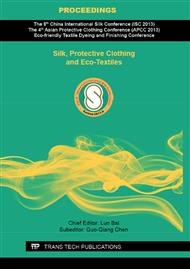p.39
p.43
p.48
p.57
p.62
p.67
p.72
p.79
p.83
Analysis of Differential Expression Proteins from Different Parts of Pistillate Flower in Mulberry (Morus alba)
Abstract:
Fruit mulberry cultivation has become a new field of modern sericulture, and quite a number of studies were focused on the growth and development of mulberry flowers and fruits. In order to explore the molecular mechanism of development and regulation of mulberry pistillate flower, the total protein were extracted from the flowering style (with the stigma) and ovary with fruit mulberry variety "Da 10" as materials, separated by two-dimensional electrophoresis and identified by mass spectrometry. The results showed that there were significant differential expressions in different tissues, and 20 proteins with specific expression were detected in the style of pistillate flower. By mass spectrometry analysis, database retrieval and bioinformatics software analysis, these protein components were given functional annotation, mainly related to the biosynthetic metabolism of protein and flavonoid, stress response and redox reaction. Additionally, glucan endo-1,3-beta-glucosidase involved in cell wall metabolism was detected to be up-regulated expression and lipoxygenase participating in membrane lipid oxidation reaction was detected to be down-regulated expression in the style compared with that in the ovary. It illustrated that the differential expression of these proteins in style were closely related to pollen germination, pollen tube growth or intrusion of other xenobiotics.
Info:
Periodical:
Pages:
62-66
Citation:
Online since:
September 2013
Authors:
Price:
Сopyright:
© 2013 Trans Tech Publications Ltd. All Rights Reserved
Share:
Citation:


